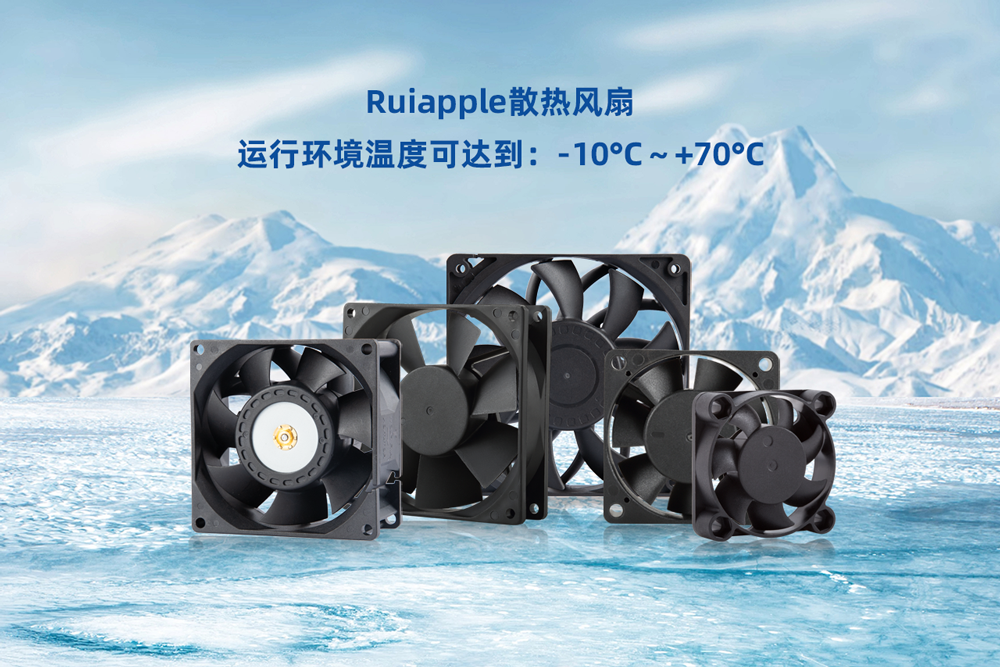Cooling fans are essential for managing heat in various industrial and consumer devices. However, many users may notice that cooling fan manuals specify a minimum operating temperature. This limitation is in place because low-temperature environments can negatively impact the fan’s key components, potentially disrupting normal operation and shortening lifespan. Here are the main factors that restrict cooling fan performance in low temperatures:
Low-Temperature Limits of Electronic Components
Cooling fans include control circuit boards and electronic components like semiconductors, capacitors, and resistors, each with a specific operating temperature range (generally from -10°C to 70°C). Exposure to temperatures below this range can cause:
- Performance Degradation: Semiconductors may slow down and resistances increase, impairing control circuit function.
- Risk of Capacitor Damage: Low temperatures can freeze electrolytic substances within capacitors, leading to failure or damage, which impacts fan stability.
- Reduced Reliability: Prolonged low-temperature exposure can cause solder joints to crack and circuit boards to fail, significantly reducing fan lifespan.

Reduced Performance of Mechanical Lubricants in Low Temperatures
Lubricants play a crucial role in cooling fans by reducing friction and wear in bearings. However, in low temperatures, the viscosity of lubricants increases, potentially freezing and rendering lubrication ineffective.
- Loss of Lubrication: When the temperature drops, lubricants become too viscous to flow, compromising the lubrication of bearings. This increases friction, leading to slower fan speeds or even stalling.
- Accelerated Wear: Insufficient lubrication causes direct friction on bearings, accelerating wear and possibly resulting in component failure.
- Increased Noise: Without proper lubrication, bearings generate abnormal noise, directly indicating lubrication failure in low-temperature conditions, which affects fan performance.
Brittleness of Fan Materials in Low Temperatures
Cooling fan housings and blades are typically made from plastic or metal, but some materials become more brittle at extremely low temperatures, losing impact resistance.
- Accelerated Material Aging: Certain plastics age more quickly and are prone to cracking in low temperatures, affecting the fan’s structure and appearance.
- Reduced Strength: Critical components like fan blades can become brittle and may crack or break at high speeds, compromising fan stability.
Other Low-Temperature Impacts on Fan Performance
Low temperatures affect not only the mechanical and electronic components but can also cause unexpected issues in fan performance, such as:
- Starting Difficulty: At extremely low temperatures, the fan’s starting current requirement increases, making it harder to start or run smoothly.
- Higher Energy Consumption: The motor load increases in low temperatures, raising energy consumption and lowering efficiency.
- Unstable Operation: Low temperatures can lead to variable fan speeds, affecting the overall cooling effect.
Technical Support from Ruiapple Electric
As a company with years of experience in cooling fan design and manufacturing, Ruiapple Electric prioritizes fan stability across different environments. The minimum operating temperature of cooling fans is set to ensure durability and efficiency, preventing abnormal wear and component failures due to low temperatures. When selecting a fan for low-temperature conditions, it’s essential to consider the minimum operating temperature specified, ensuring proper use within the recommended range. We offer cooling fans with extensive temperature adaptability to ensure reliability in extreme conditions. For any questions or needs regarding cooling fan performance in low temperatures, visit Ruiapple Electric for professional insights and solutions.






